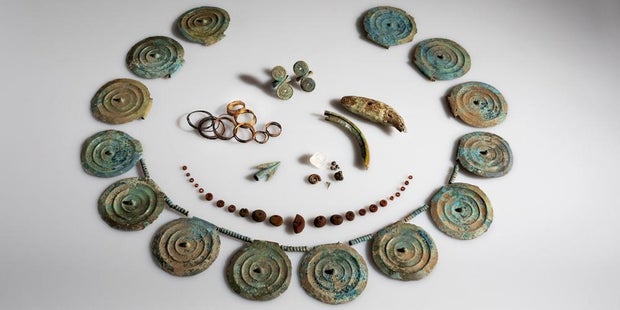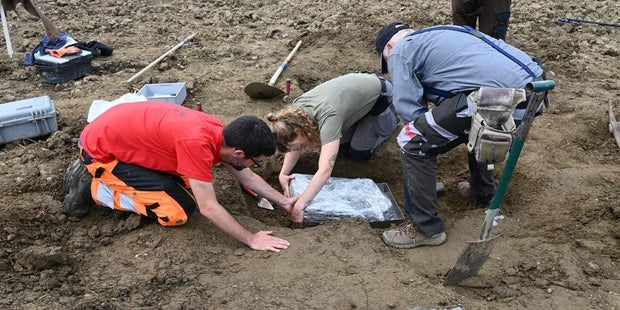
Posted on 10/19/2023 11:38:40 AM PDT by Red Badger
A man with a metal detector searching a freshly plowed carrot field in Switzerland found a large ornate jewelry set dating to the Bronze Age — as well as other surprising items including a bear's tooth, a beaver's tooth and a fossilized shark's tooth, local officials said this week.
Franz Zahn made the unusual discovery in August while he was "out and about in a freshly harvested carrot field" in Güttingen, about 50 miles northeast of Zurich, officials from Thurgau Canton said in a Monday news release. Zahn initially found a bronze disc, and immediately realized it was an "extraordinary discovery" so he contacted local authorities.
A team of experts identified the discovery as a necklace and large jewelry set from the Middle Bronze Age, which dates to about 1500 B.C., officials said. Archaeologists later excavated a block of soil where the discovery was made and found a host of other artifacts — including rings, wire spirals made of gold and more than 100 amber beads.

The hoard includes a necklace with spiked discs, an amber necklace, finger rings, gold spirals and special finds such as a bear's tooth and an ammonite.
THURGAU CANTON
Experts also made some other "surprising" finds — a bronze arrowhead, a beaver tooth, a bear tooth, a fossilized shark's tooth, a rock crystal and a small ammonite.
In total, eight spirals made of gold and 14 bronze spiked discs with grommets were recovered, indicative of "costume jewelry" worn by women about 3,500 years ago, according to the news release.
Local officials said that the unusual discovery triggered several questions: "Has a jewelry box been hidden here? Were the bear tooth, the rock crystal and the selected fossils and stones a collection of curiosities or souvenirs … ? Or is there more to it?"
Experts noted that the array of found objects were said to have "a special, protective or healing effect" and may have been worn as a kind of amulet.
Officials said that Zahn was very familiar with Güttingen and previously made other discoveries, including scrap metal and objects from the Iron Age and Bronze Age. The artifacts are being restored so that they can be exhibited in the Museum of Archaeology in Frauenfeld, Switzerland.
A video posted by Thurgau Canton showed the jewelry being restored in a lab.
 Block salvage of the Güttingen depot find.
Block salvage of the Güttingen depot find.
THURGAU CANTON
The unusual find in Switzerland follows other recent discoveries of ancient treasure found by people with metal detectors in Europe.
Earlier this month, two sets of coins found by metal detectors in Wales turned out to be Roman treasure, officials confirmed.
In September, a Norwegian family looking for a lost earring in their garden instead discovered artifacts dating back more than 1,000 years. Just weeks before that, officials revealed that a man with a metal detector made the "gold find of the century" in Norway.
Trending News

Thanks for the chuckle :D
Lol! Capt. Kangaroo played that song a number of times on his show.
Yes, it was one of my faves........................
Doing that loses all archaelogical information.
Let me take you down, cause I’m going to a carrot field, nothing is real...
So were they 24 carrot jewels?
Other than being an interesting story, of what real value is that archaeological information? It indicates that someone of means was there at some time in the past, but who, when, and why was it lost? They can only speculate. More interesting stories.
One of my neighbors heard that a meteorite had struck in our county in the 1940s. He researched old copies of our local weekly paper and from its reporting found it seemed to be on the land he currently owned. So he searched and found an indentation on his farm that looked suspicious.
Next he found a piece of weird looking rock and took it to a specialist to see if it was a part of a meteorite. It actually was and the rock is now in a museum on display. Unfortunately, he didn’t find any gold to go with it. There is also a rumor that a wagon of gold disappeared in our county en route to Savannah back during the civil war. We are still looking but thus far all we have found on our property is an old horse shoe. LOL!
Art. 723 Swiss Civil Code
4. Treasure trove
1 If an object of value is found in circumstances indicating with certainty that it has lain buried or hidden so long that it will not be possible to trace its owner, it is treated as treasure trove.
2 Subject to the provisions governing objects of scientific value, treasure trove belongs to the owner of the land or chattel where it was found.
3 The finder is entitled to an appropriate finder’s reward not exceeding one-half of the treasure’s value.
- & -
Art. 724 Swiss Civil Code
5. Objects of scientific value
1 Ownerless natural specimens and antiquities of scientific value are the property of the canton on whose territory they are found.
1bis Such objects must not be alienated without the consent of the competent cantonal authorities. They may not be purchased in good faith or acquired through adverse possession. There is no time limit on the canton’s right to recover them.
2 The owner of the land on which such objects are found is obliged to permit their excavation in exchange for compensation for the damage caused.
3 The finder, and in the case of treasure trove also the owner is entitled to an appropriate finder’s reward not exceeding one-half of the value of the find.
LOL!
Thanks Red Badger.
Other than being an interesting story, of what real value is that archaeological information? It indicates that someone of means was there at some time in the past, but who, when, and why was it lost? They can only speculate. More interesting stories.
A lot can be learned. However, if some metal detectorist takes shovel and pick willy nilly only to get some metal finds to sell for a quick $ on the black market, a lot can be lost. So, IMO he did the right thing by notifying authorities so qualified archaeologists could do their work.
Since the initial find was made in plow soil it was probably not in situ but a lot can still be learned. Were these grave goods? Could this discovery lead to others? Is there a Bronze Age settlement nearby? The presence of amber beads is interesting since most amber comes from the Baltic regions. This could indicate either trade or migration.
Some sites also show evidence of near continuous occupation from the neolithic through the Bronze and Iron age and even later. The Romans often made settlements on earlier Bronze and Iron age sites in Brittan just as the Anglo-Saxons often settled on earlier Roman sites and the Normans on earlier Anglo-Saxon sites.
Some early Christian churches from both the Christianized Anglo-Saxon period and the Norman period show stones that had been "robbed" from earlier Roman buildings, some still with Roman/Latin inscriptions on them.
A metal detectorist only interested in high value metal finds would have likely missed the beads, the animal teeth or even the small rings.
I watched this the other night. A road widening project in Essex UK in 2003 led to the discovery of an intact Saxon burial chamber dating to around 580 AD.
www.youtube.com/watch?v=DFzqDn2lOz8
https://en.wikipedia.org/wiki/Prittlewell_royal_Anglo-Saxon_burial
This was obviously a high-status burial but what makes it interesting aside from the incredible level of preservation and goods found, is that the body had been laid in a wooden coffin, with two small gold-foil crosses, one over each eye and a silver spoon engraved with a cross which would indicate a Christian burial. But a burial chamber with many grave goods indicates a pre-Christian/pagan burial. It is thought that he had been laid in the coffin by Christians, and that the coffin had been then buried by pagans, reflecting divided and shifting attitudes towards Christianity at the time.
Similar gradual shifts in culture and religion can also be found at some British-Romano excavation sites.
We tend to think that all Roman era sites in Brittan were made by “Italian” Romans (FWIW many of those garrisoned in Brittan came from outside Italy) but that is not the case. Not all, but many Celts adopted Roman culture, building technics and religion, but the change was gradual. Near some Roman era forts outlying settlements show a mixture of traditional Iron Age round houses and Romanized buildings dated to the same period - but with wooden posts and wattle and daub walls as would be with a round house, but with built on stone foundations, tile roofs and painted plastered walls and mosaic floors on the inside.
Conversely some Romans garrisoned in Britania adopted and or incorporated Celtic customs and religious practices.
You do not learn these things by digging up the dirt looking only for treasure.
Well put.
Thank you!
Never bring teeth to a carrot fight.
(yeah I know that doesn’t make sense)
Disclaimer: Opinions posted on Free Republic are those of the individual posters and do not necessarily represent the opinion of Free Republic or its management. All materials posted herein are protected by copyright law and the exemption for fair use of copyrighted works.